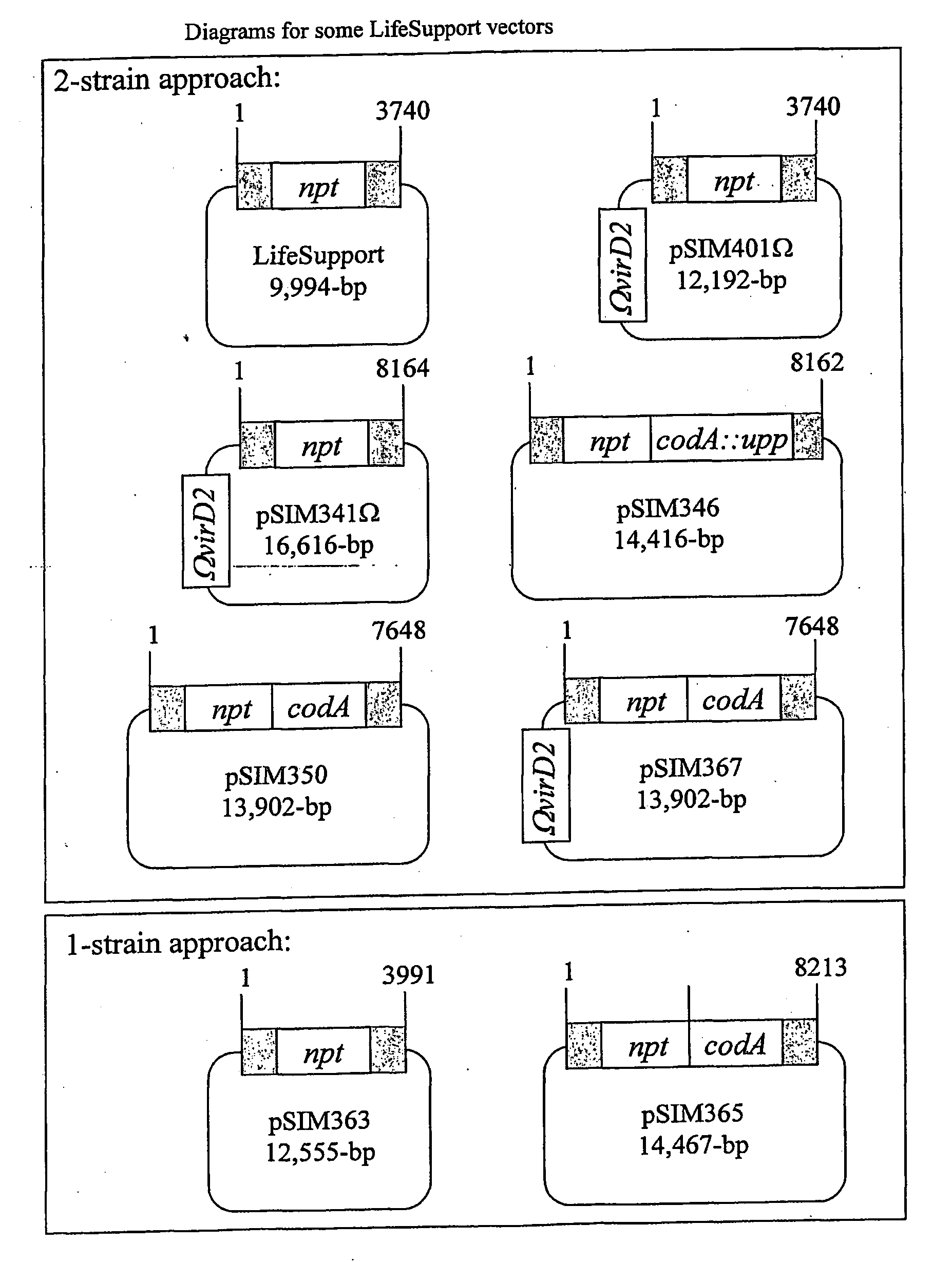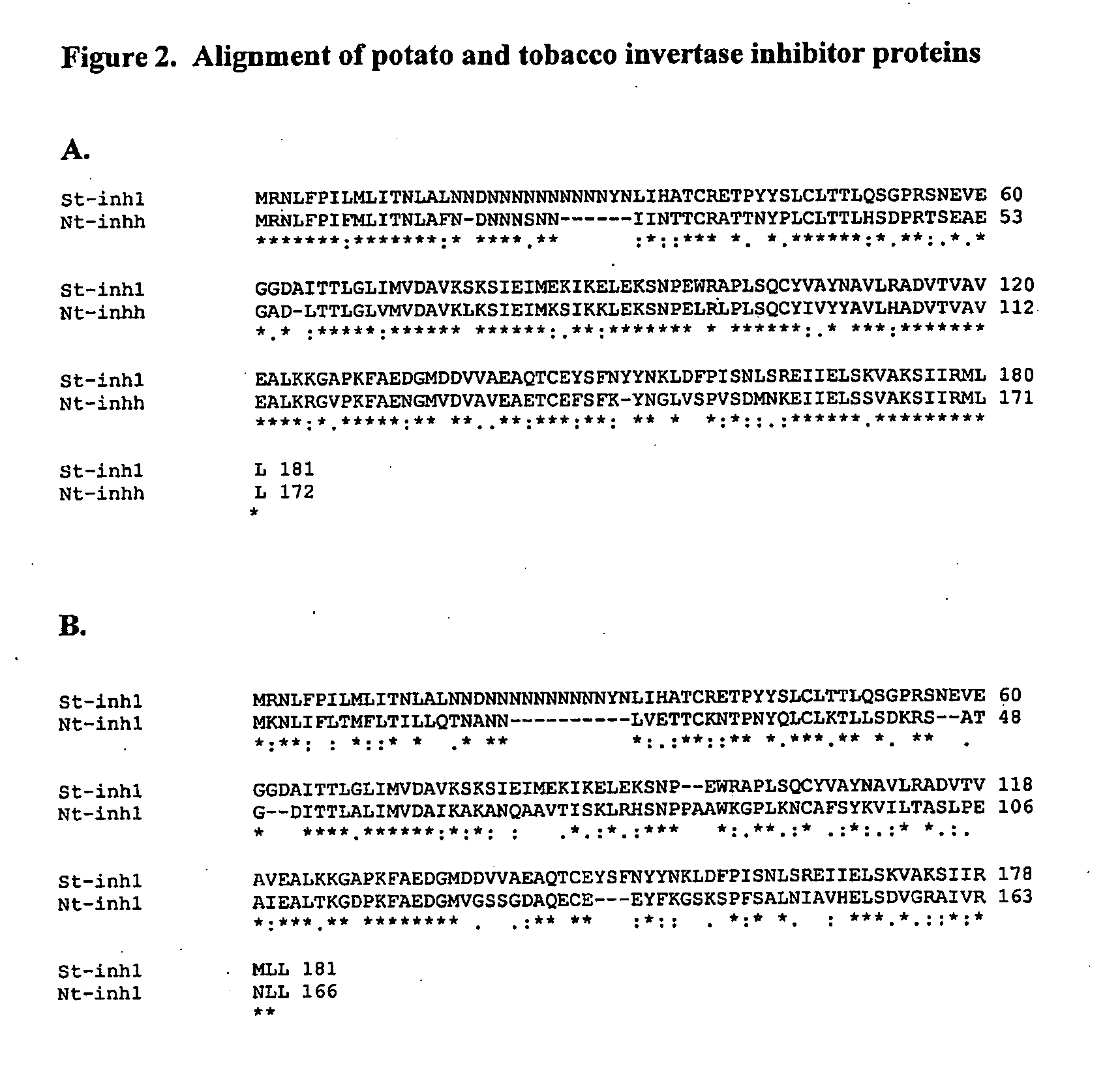Precise breeding
a technology of precise breeding and genetics, applied in the field of precise breeding, can solve the problems of inability to accurately predict the effect of genetic variation, so as to facilitate the down-regulation of gene expression and facilitate the effect of gene down-regulation
- Summary
- Abstract
- Description
- Claims
- Application Information
AI Technical Summary
Benefits of technology
Problems solved by technology
Method used
Image
Examples
example 1
Cloning of P-DNAs
[0325]This example demonstrates that T-DNA borders are specific to Agrobacterium. It also shows that plants contain T-DNA border-like sequences, and it provides the sequence of DNA fragments isolated from potato and wheat that are delineated by such border-like sequences.
[0326]Conventional transformation systems use Agrobacterium-derived T-DNAs as vehicles for the transfer of foreign DNA from Agrobacterium to plant cells (Schilperoort et al., U.S. Pat. No. 4,940,838, 1990). Although T-DNAs usually comprise several hundreds of basepairs, delineated by a left-border (LB) and right-border (RB) repeat, they can also merely consist of such borders. The T-DNA borders play an essential role in the DNA transfer process because they function as specific recognition sites for virD2-catalyzed nicking reaction. The released single stranded DNA, complexed with Agrobacterial virD2 and virE2, is transferred to plant cell nuclei where it often integrates successfully into the plant...
example 2
Tobacco Transformation with P-DNA Vectors
[0340]This Example demonstrates that, despite structural (sequence divergence) and functional (transformation frequencies) differences between P-DNA termini and T-DNA borders, a P-DNA can be used in a similar way as a T-DNA to transfer DNA from Agrobacterium to tobacco cells.
[0341]A T-DNA-free vector that can be maintained in both E. coli and A. tumefaciens was obtained by removing the entire T-DNA region of the conventional binary vector pCAMBIA1301 (Cambia, AU). This was accomplished by simultaneously ligating a 5.9 kb SacII-SphI fragment of pSIM1301 with 2 fragments amplified from pCAMBIA1301 using the oligonucleotides pairs: 5′-CCGCGGTGATCACAGGCAGCAAC-3′ (SEQ ID NO. 58) and 5′-AAGCTTCCAGCCAGCCAACAGCTCCCCGAC-3′ (SEQ ID NO. 59), and 5′-AAGCTTGGCTACTAGTGCGAGATCTCTAAGAGAAAAGAGCGTTTA-3′ (SEQ ID NO. 60), and 5′-GCATGCTCGAGATAGGTGACCACATACAAATGGACGAACGG-3′ (SEQ ID NO. 61), respectively.
[0342]To make it possible to screen against backbone integra...
example 3
Potato Transformation with P-DNA Vectors
[0348]This Example demonstrates that a P-DNA can be used in a similar way as a T-DNA to transfer DNA from Agrobacterium to potato cells.
[0349]Potato transformations were carried out by infecting stem explants of 4-week-old in vitro grown Russet Ranger plantlets with Agrobacterium strains according to the following procedure. Ten-fold dilutions of overnight-grown cultures were grown for 5-6 hours, precipitated for 15 minutes at 2,800 RPM, washed with MS liquid medium (Phytotechnology) supplemented with sucrose (3%, pH 5.7), and resuspended in the same medium to an OD600nm of 0.2. The resuspended cells were then used to infect 0.4-0.6 mm internodal potato segments. Infected stems were incubated for 2 days on co-culture medium (1 / 10 MS salts, 3% sucrose, pH 5.7) containing 6 g / L agar at 22° C. in a Percival growth chamber (16 hrs light) and subsequently transferred to callus induction medium (CIM, MS medium supplemented with 3% sucrose 3, 2.5 mg / ...
PUM
| Property | Measurement | Unit |
|---|---|---|
| temperature | aaaaa | aaaaa |
| temperature | aaaaa | aaaaa |
| temperatures | aaaaa | aaaaa |
Abstract
Description
Claims
Application Information
 Login to View More
Login to View More - R&D
- Intellectual Property
- Life Sciences
- Materials
- Tech Scout
- Unparalleled Data Quality
- Higher Quality Content
- 60% Fewer Hallucinations
Browse by: Latest US Patents, China's latest patents, Technical Efficacy Thesaurus, Application Domain, Technology Topic, Popular Technical Reports.
© 2025 PatSnap. All rights reserved.Legal|Privacy policy|Modern Slavery Act Transparency Statement|Sitemap|About US| Contact US: help@patsnap.com



